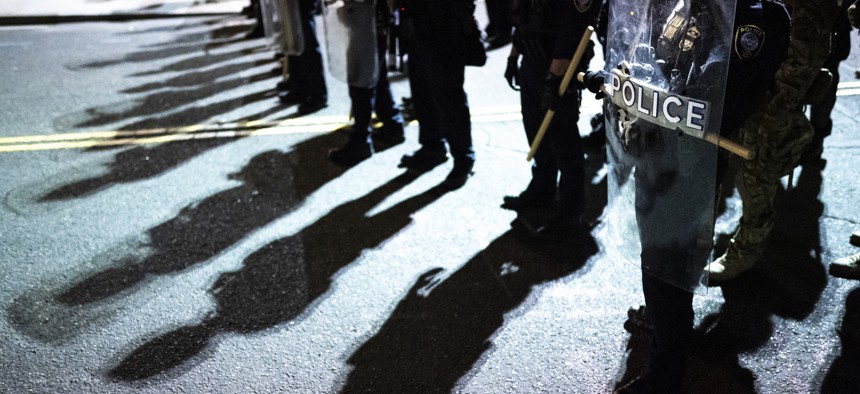As a Black Woman Mayor, I Paid the Price for Police Reform. And I Am Not Going to Stop.

iStock/E4Z
COMMENTARY | Implementing meaningful reforms to curb police violence remains an uphill battle for many mayors and can come at great personal cost.
As the first Black woman mayor of my hometown, Kankakee, Illinois, I have seen a significant change in my local police force. When I was growing up in Kankakee, police officers of different races were integrated in our community. We’d see them at church, the grocery store and at neighborhood events. However, over the years, a disconnect developed between the residents and the police force. This has been partially driven by an increased number of police officers, particularly white officers, not living in the city in which they serve. I had one officer tell me that he doesn't live in the City because he didn't want his kids being picked on. Others have made comments that they are not living in the city that has shots-fired calls. From my perspective, this disconnect has contributed to a decline in terms of community relations.
When I became mayor, one of my chief priorities was to change this dynamic and implement reforms to eliminate police brutality. Mayors are necessary actors in police reform. As mayors, we acknowledge and grapple with the range of opinions within our communities about how to achieve those goals. Many of us have long worked to end police violence because our communities want and deserve real safety. And residents want to hold law enforcement accountable for its actions.
Mayors are also human. This work is emotional and difficult. We engage in this work even as people like me continue to be battered by the constant barrage of news especially since the horrific murder of George Floyd last summer about Black people and other people of color—including children—killed by police.
While we seek to engage with our humanity, we also use data and logic to identify effective solutions, and reject reforms that have been far less successful. Data-driven policy efforts give us reason to hope that we can curb police violence. For example, we are working toward fundamental and necessary culture change within police departments by changing who our police departments seek to recruit (statistically, with some high-profile exceptions, women officers are far less likely to engage in violence). We can eliminate outdated training that glorifies violent interaction and portrays it as typical.
Some cities are now using unarmed city staff to address problems that do not require an armed response, like taking a report about a stolen bicycle or having social workers respond to mental health calls. Not to mention improving use of force policies, duty to intervene requirements, civil rights claims that hold police officers personally responsible, and more can track and remove “bad apple” police officers so there is real accountability and they aren’t simply moved to other departments.
Mayors Come Together to Advance Solutions
The events of the last year and the resulting movement have only galvanized many mayors to come together and further advance these solutions at the local level. After George Floyd’s murder, I worked with the Mayors Innovation Project to call upon my fellow mayors to face the scourge of police violence in our communities head on. From there, a cohort of women mayors from the Women Mayors Network answered the call to discuss our work, identify and learn from experts, and make real change in our local communities.
While necessary, some of the changes mayors are exploring are controversial and pursuing them is not without personal cost as I discovered when I lost my re-election bid for mayor. My difficulties with Kankakee’s police department started when the former police chief announced his retirement the day after I won the Mayoral election in April 2017. He had not spoken with me regarding his intentions, although he had enough years to retire.
This was just the beginning of the difficulties I would face with the police department during my time as mayor. I also experienced police officers who did not acknowledge my leadership and who have taken great offense to my vision of accountability, redefining public safety and addressing police brutality.
Additionally, after George Floyd was killed, I was the only mayor in my county calling for immediate mayoral action with an official statement, which apparently served as an affront to some of my officers who became vocal in speaking against my leadership. We had chosen to take a proactive approach to improving operations within our local department by assessing use of force policies and considering the other initiatives of the 8 Can’t Wait campaign, in which the city was not aligned.
And finally, during my re-election campaign, the Fraternal Order of Police (FOP) union endorsed my opponent. To my knowledge, the FOP had never endorsed a mayoral candidate in the city of Kankakee's history. However, while I have always publicly supported the good work of our officers while acknowledging the societal issues associated with policing in Black and brown communities, my opponent touted his support of the police and tough on crime stance, without acknowledging the depth of problems with policing in our country and the impact on municipalities with large populations of minorities such as Kankakee.
While I’m disappointed in that outcome, the backlash of my approach as mayor to address police brutality, systemic racism and oppression only affirms the need to continue to push real change forward. This is critical work for all of us. My hope is that people in communities across the country will continue to engage with their local government on creating real community safety that works for all of us.
Mayor Chasity Wells-Armstrong is the first African American woman mayor of Kankakee, Illinois.
NEXT STORY: Parents Are Vaccinated, Kids Can’t Be. That Complicates the New Masks-off Guidance





